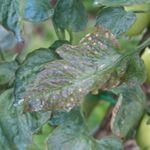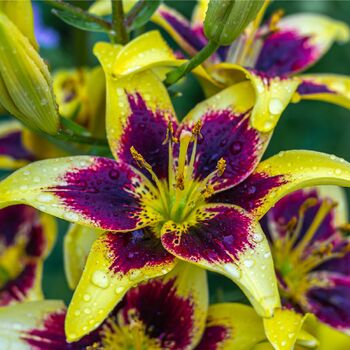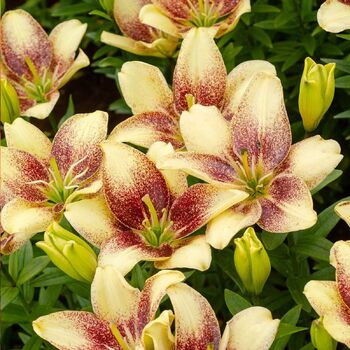
How to Grow Lily Bulbs
Grow Guide #2284
Family: Liliaceae
Binomial name: Lilium sp.
Life Cycle: perennial
This 'How to Grow' guide details everything a home gardener needs to know to plant, grow and care for Lilies (Lilium sp.).
When to Plant Lilies
Use the table below to identify the best time of year to plant lily bulbs in your climate.
| JAN | FEB | MAR | APR | MAY | JUN | JUL | AUG | SEP | OCT | NOV | DEC | |
|---|---|---|---|---|---|---|---|---|---|---|---|---|
| Cool | ||||||||||||
| Temperate | ||||||||||||
| Sub-Tropical | ||||||||||||
| Tropical | ||||||||||||
| Arid |
Preparation
Lily plants are best grown in full sun or part shade. Choose a location that will receive at least 3 hours of full sun each day. Protection from strong afternoon sun is preferable. If afternoon sun is unavoidable, take extra care with watering to prevent the soil drying out, which can cause wilting.
Lily plants need a well drained soil enriched with plenty of organic matter. Prepare soil by weeding it thoroughly, digging it over to loosen it and adding aged animal manure or compost. Keep the area free of weeds until planting. Learn more about preparing soil for planting here.
Lily plants can be grown in containers. If possible choose a variety that’s recommended for container growing. Use a good quality potting mix and make sure your container is large enough for mature plants; a minimum of 20 litres is recommended for lilies. During the growing season, keep in mind that container grown plants may need additional fertiliser to encourage healthy growth.
How to Plant Lily Bulbs
Lily bulbs are fresh (not dormant) and need to be kept moist until they are planted. Plant bulbs as soon as possible after purchasing them. Plant lily bulbs directly into the garden or container in clusters so the stems can support each other as they grow.
- Plant individual bulbs 20-40cm apart (7-10cm apart in containers) and 10-15cm deep with the roots at the bottom.
- Cover with soil and water in well.
- Keep soil moist but not wet until shoots emerge.
How to Grow Lilies
Lily plants may need watering during the growing season. Water when the soil is dry about 5cm below the surface (test this by scratching away a little soil with your finger). Water deeply in the early morning or late afternoon. Avoid watering the leaves of plants to avoid fungal diseases. Learn more about watering here.
To help keep moisture in the soil and keep the lily's roots cool, apply a thick layer of organic mulch such as lucerne or pea straw before summer.
When plants begin to form buds, apply a balanced liquid or slow release fertiliser at the recommended rate to prevent the lower leaves from turning yellow.
Lilies should be ready to harvest in approximately 70-120 days.
Cut flowers when the first buds just begin to open. Cut about halfway down the stem, strip the lower leaves from the stem and plunge it into a bucket of clean water for a few hours before recutting the stem at a 45° angle and transferring it to a vase.
Optional: The anthers can be cut or gently pulled off each flower to stop pollen falling onto the petals and staining tables or fabric.
If plants have been left to bloom in the garden, cut back after flowering, leaving half the stem to provide nutrients to the bulb so it will flower next year.
When plants have finished flowering, top dress with compost or apply a balanced slow release fertiliser at the recommended rate. When foliage has completely died, cut the stem at ground level.
Bulbs can be left in the ground to flower in future years. If the clump becomes overcrowded, lily bulbs can be lifted, divided and replanted in late autumn or early winter.
Common Problems when Growing Lilies
Like all plants, lily is susceptible to some pests, diseases and other problems. Below is a list of the most common problems gardeners encounter when growing lily plants:
 Aphids are small (2-4mm long) sap-sucking insects that congregate on the new shoots or the undersides of leaves. They can cause leaves to wilt or become discoloured, and also excrete honeydew which can attract ants and other insect pests. To manage aphids, remove them by spraying with a garden hose, apply a soap or alcohol spray, or encourage predatory insects to your garden. Read more about aphids here.
Aphids are small (2-4mm long) sap-sucking insects that congregate on the new shoots or the undersides of leaves. They can cause leaves to wilt or become discoloured, and also excrete honeydew which can attract ants and other insect pests. To manage aphids, remove them by spraying with a garden hose, apply a soap or alcohol spray, or encourage predatory insects to your garden. Read more about aphids here. Downy mildew is a fungal disease that causes yellow to grey-brown patches on leaves, especially the undersides. Water plants at soil level (not on the leaves), remove and destroy affected leaves and do not overcrowd plants to ensure adequate air flow. If problems persist, spray with a homemade milk spray or fungicide.
Downy mildew is a fungal disease that causes yellow to grey-brown patches on leaves, especially the undersides. Water plants at soil level (not on the leaves), remove and destroy affected leaves and do not overcrowd plants to ensure adequate air flow. If problems persist, spray with a homemade milk spray or fungicide..jpg) Rotten bulbs or corms are caused by pathogens entering bulbs or corms after sitting in cold, wet soil, being temporarily waterlogged or being exposed to warm temperatures in winter. They may show obvious signs of rot, have no roots or shoots, or produce stunted yellow leaves but no flowers. Plant bulbs and corms in free-draining soil, raised garden beds or containers; do not water while dormant; and lift and store them if recommended for your climate.
Rotten bulbs or corms are caused by pathogens entering bulbs or corms after sitting in cold, wet soil, being temporarily waterlogged or being exposed to warm temperatures in winter. They may show obvious signs of rot, have no roots or shoots, or produce stunted yellow leaves but no flowers. Plant bulbs and corms in free-draining soil, raised garden beds or containers; do not water while dormant; and lift and store them if recommended for your climate. Slugs and snails are molluscs that feed on tender leaves and shoots, mostly at night, leaving slimy trails behind them. Control them by removing their hiding places, keeping free range poultry, collecting them by torchlight or by placing traps. Read more about slugs and snails here.
Slugs and snails are molluscs that feed on tender leaves and shoots, mostly at night, leaving slimy trails behind them. Control them by removing their hiding places, keeping free range poultry, collecting them by torchlight or by placing traps. Read more about slugs and snails here.


.png)






